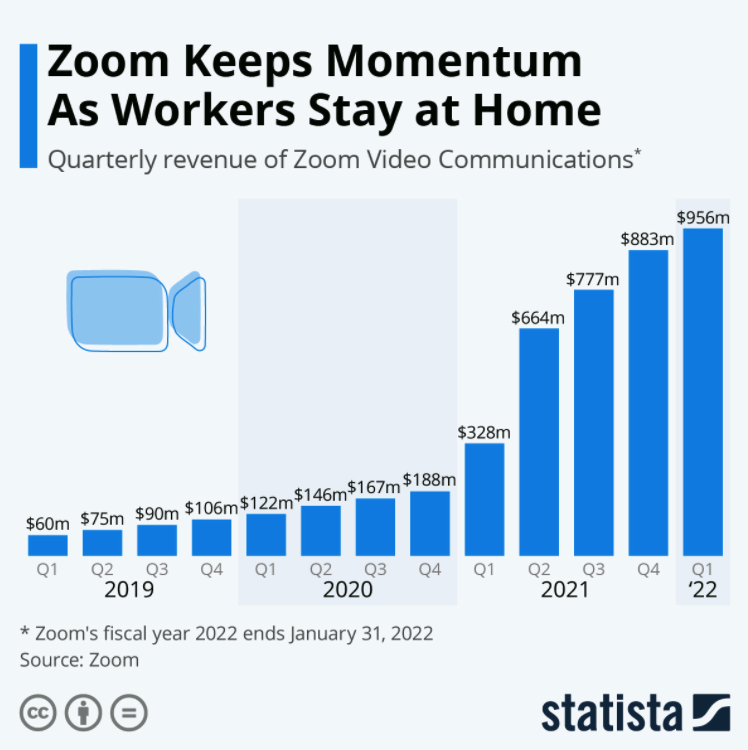Whilst the general consensus about working from home is positive, because of the travel cost reduction, the reduced commute time and general flexibility of the working from home day, the loss of working within an empirical team of course doesn’t really exist anymore. Statistics show that in the Netherlands alone, prior to the pandemic, teamwork predominantly took place face to face which was a more accessible form of team collaboration and team projects.

(Source: Statista)
Although the opportunity to have face to face meetings has been drastically reduced, the concern of team collaboration not being as effective can be solved by making use of the tools available for team working in a remote world.
Virtual and Online Spaces
Just as you would take a break in the office, or use the time to perhaps take a small wander away from your desk is also important when working from home. Having a dedicated virtual space can be a great tool to use when networking and working as a team. The element of natural and causal networking is something that may be missing when working from home, but creating virtual places that are a place for people to stay connected could try and simulate this as best as possible. Think of it as a virtual coffee station. Using tools such as Slack to create chat specific chats and be a great communicative tool that allows for small talk and is dedicated space away from work that you would normally have when working face to face in an office.
This type of encouraged virtual space is a great way to keep morale high and can be a great aid to not feeling so isolated. Whilst virtual spaces will never mirror real-life meetings, it can be a great aid to stay connected and a smooth tunnel of introduction for new members of staff and trainees.
The social elements of virtual space are apparent and important, but when it comes to team collaboration and project management, the use of collaboration to-do lists and documents can help virtually align everyone. The utilisation of platforms such as Trello or Monday.com provide clear instructions and keep the gateway of communication open without having to be in constant interaction. This is a sure-fire way to allow employees to manage their responsibilities and keep a project flowing in the right direction.
Real-Time Chat and Video Conferencing
Email is a tried and trusted way of communication, but having an inbox full of incoming messages and tasks can slow down a process that would otherwise be solved within seconds when working in an office. An efficient method that can reflect the instantaneous nature of face to face interaction is instant messaging and the effective use of video chat.
The utilisation of real-time chat software, such as Slack or even an in company messenger service would allow employees to quickly ask questions and receive a real-time answer as well as being used as a tool to build rapport. This also encourages the remote nature of the job and being reached even if you’ve stepped away from your desk.

(Image showing growth in Zoom’s revenue. Source: Statista)
This way of communication can be synced up with our technology wearables and encourage reduced screen time and in turn problems like digital eye strain, considering the fact that already, 75% of adults require some form of vision correction. When you’re chatting with someone in the office, you’re not constantly looking at a screen, so why would you do so at home?
The pre-planning of video meetings is a reliable way to check in on teams and encourage successful remote collaboration. However, you should translate how useful those meetings are when managing a project, if you wouldn’t have those meetings whilst in the office, how necessary are they when working from home?
By keeping meetings predictable and regular, but not too overwhelming you can remotely network and work together as a team. Although email can be overwhelming, if your meeting can be summarised via email, this also contributes to efficiency. Keeping meetings to a minimum can actually increase productivity if the meetings are planned and have a clear line of purpose.
There are ways video meetings and conferences can be streamlined and categorised and companies such as Blueprint have implemented some example categories.
- Daily check-Ins: Having regular video call check-ins can be a great way to check in with the entire team and answer any questions before the full workday begins. Setting up for the day and ensuring that a whole team is on the same page is important to create a streamlined way of working and get the day started in the right way. Although daily video check-ins can be useful, some companies opt for catch-ups every other day and the beauty of video calling is it can be adapted to the needs of individual teams.
- Bi-Weekly Zoom Party: This type of video conference can be a hosted call specifically dedicated to having fun and getting to know members of the team. Sometimes stepping away from a project can be the catalyst for innovative ideas and generally communicating in a less incentivised way.
- Monthly All-Company: All-Company meetings are a way to host more formalised meetings with the entire company and have a booked time where the senior members on the team can update everyone and relay updates that are happening within the business.
These examples alone are just a suggested rubric to promote project collaboration and healthy workplace communications. The implementation of what is expected when it comes to video and virtual communication is a must in order to make sure that remote working and team collaboration is a success.
Setting Healthy Boundaries
Setting clear boundaries when it comes to remote collaborations is key and is something that ought to be enforced when working from home. Separating your work and home life when working remotely is difficult enough as it is, so it’s important that when working on a team people are on the same page and working on the same timelines.
When these boundaries are established from the get-go, there is an awareness of when you can be reached and when you’re not going to respond. There is no inclination to work unnecessary overtime when people are effectively using their working hours. By planning remote team interactions, employees can navigate this with their workspace environment and be mindful of anyone they might be sharing a space with.
Task Tracking and Productivity
Using video conferencing and emails provide a significant way of checking in with a team to update on progression, but the new way of working has resulted in task tracking being key to success. By making use of tools such as, Status Hero allows progression to be tracked and overlook where people are without direct communication and potential micromanaging.
Team members can see what everyone else is currently working on and statuses with current tasks and results in little to no interruptions when a team can just check-in and know when you’re busy on something. Software like this, just like with instant messaging, gives a real-time look at team progress and helps combat the issues that come with remote working.
Avoiding Micromanaging
Micromanaging is a type of management that means that senior employees often control every part (however small) of an enterprise or business. It can mean checking in at all times and ensuring that everything is done in a very subjective way. This in turn can lead to a stunt in imaginative ideas to members of staff feeling that they are working in a toxic work environment. As so many companies and businesses have had to go remote over the past year, the tendency to check in on employees can feel like an obligation when you don’t have an office space to oversee what’s happening in person, but using the right tools avoiding micromanagement is important.
Checking in with team members is of course a must, in order to make sure that support is available and processes are being understood. With this in mind, micromanaging should be avoided as it can result in incentivising staff to feel checked upon and it’s not always productive.
To avoid micromanaging, use the task managing tools and real-time chat to leave employees to their own devices and become more self-reliant. By stepping back and managing from a macro level, you can allow autonomy and give more responsibility to your employees creating an all round better team.
Using the wide range of online tools and working methods and practises, team collaboration can most certainly be upheld in a new remote working world. Although the everyday office culture may be gone, the new methods of working can be an exciting change to look forward to. With the inevitability of remote working long term, the adaptability of staff can be a great way to experiment and cement new working practices and not compromise on effective team collaboration.
Business & Finance Articles on Business 2 Community
(119)
Report Post




